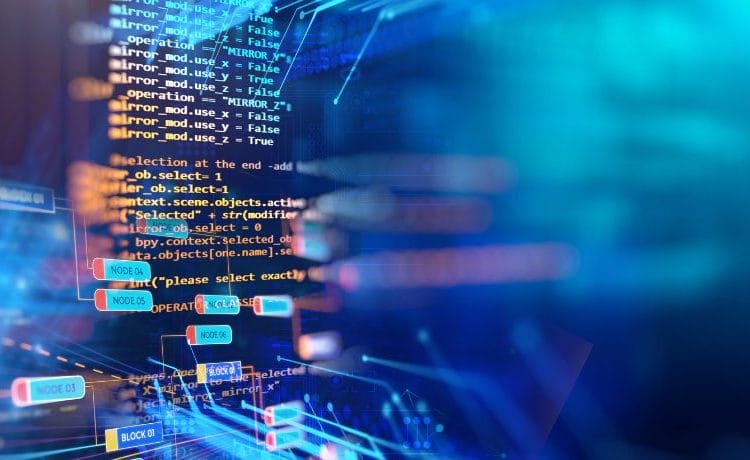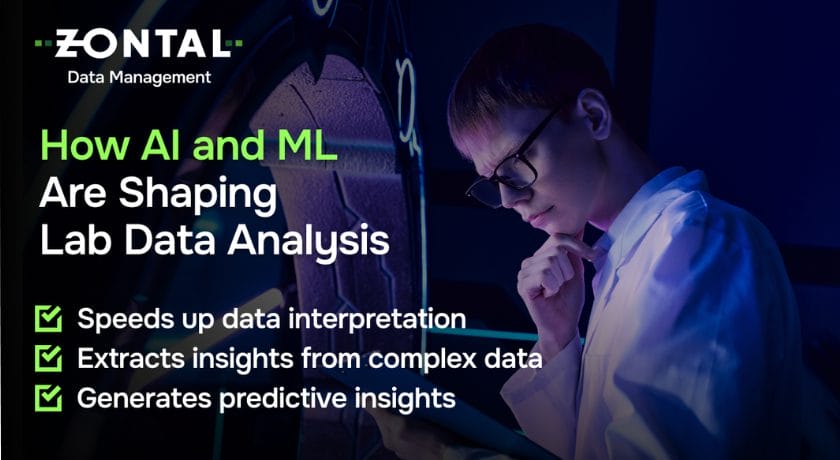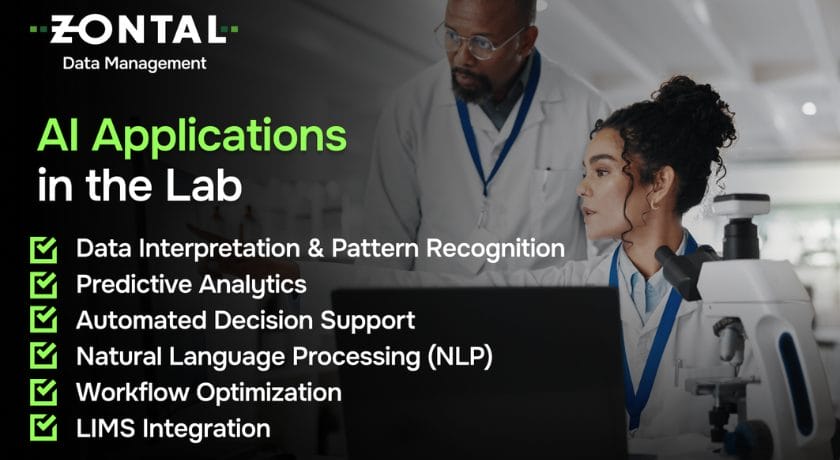Leveraging AI & ML for Laboratory Data Analysis + FAQs

AI in Lab Research Explained: Key Takeaways
- AI and ML enhance lab research by automating analysis, boosting reproducibility, and enabling predictive insights
- AI and ML aid reproducibility by standardizing data processing, eliminating manual variability, and ensuring consistent, traceable experimental outcomes
- Reliable AI depends on harmonized data from ELNs, LIMS, and instruments, structured for quality and compliance
- ZONTAL makes lab data AI-ready with FAIR principles, real-time analytics, and tailored research support
As labs produce more complex data, AI and machine learning are transforming research, converting raw inputs into real-time insights and predictive models.
They drive faster decisions, greater reproducibility, and deeper discovery in life sciences and pharma.
In this guide, we will:
- Explore how AI and ML are transforming lab environments
- Break down key machine learning techniques used in data-intensive research
- Share how platforms like ZONTAL are making lab data AI-ready from the ground up
Simplify complex data with ZONTAL.
How AI and Machine Learning Are Transforming Laboratory Data Analysis
AI is transforming lab operations by automating routine tasks, accelerating data analysis, and supporting real-time decisions. This means augmenting, not replacing, human expertise.
1. Life Sciences Research
AI and machine learning are supercharging innovation in life sciences, from protein modeling and omics analysis to predicting drug-target interactions.
ZONTAL enables this by unifying data from ELNs, LIMS, and instruments and structuring it according to FAIR principles, ensuring it’s machine-ready and primed for reuse in AI and analytics pipelines.
2. Pharmaceutical Laboratories
Pharma leaders use AI to optimize drug development, manufacturing, and clinical trials.
AI also fast-tracks trial data analysis, cutting timelines and labor. Initiatives like AION Labs, backed by AstraZeneca and Pfizer, leverage AI to speed up drug discovery, signaling a major shift in how new therapies are developed.

Key Machine Learning Techniques for Laboratory Data
Here’s how core machine learning methods drive data analysis, prediction, and automation in lab environments.
1. Supervised Learning for Predictive Modeling
Supervised learning techniques, like random forests, SVMs, and gradient boosting, use labeled data from screens or assays to predict outcomes such as efficacy, toxicity, or reaction conditions.
Use case: Predicting biological activity of new drug compounds from chemical structure and assay data.
2. Unsupervised Learning for Pattern Discovery
Techniques such as k-means clustering, hierarchical clustering, and principal component analysis (PCA) uncover hidden patterns or natural groupings in complex lab datasets.
Use case: Grouping gene expression profiles to identify disease subtypes or response patterns in clinical samples.
3. Anomaly Detection
Anomaly detection algorithms, often built with autoencoders or isolation forests, are instrumental in quality control.
They help flag unexpected data variations that could indicate equipment malfunctions, contamination, or procedural errors.
Use case: Detecting deviations in lab instrument outputs during stability studies or routine diagnostics.
4. Natural Language Processing (NLP)
NLP is used to extract structured insights from unstructured data such as lab notebooks, SOPs, or historical reports.
Techniques like named entity recognition (NER) and text classification automate metadata annotation and help index data for search and reuse.
Use case: Extracting compound names and test parameters from free-text ELN entries to integrate with structured LIMS data.
5. Reinforcement Learning for Lab Automation
In automated labs, reinforcement learning (RL) is applied to optimize sequential decision-making tasks, such as adjusting experimental protocols in real time based on ongoing results.
Use case: Tuning control parameters in automated fermentation processes to maximize yield.
6. Time Series Analysis
Recurrent neural networks (RNNs) and temporal convolutional networks (TCNs) are deployed to model sensor data streams and forecast equipment behavior or environmental conditions in controlled lab settings.
Use case: Predictive maintenance of chromatography systems based on historical performance logs.
7. Data Harmonization With AI
ZONTAL’s strategy supports data harmonization and semantic enrichment to make diverse lab data interoperable across LIMS, ELNs, and instruments, laying the foundational infrastructure required for future AI and machine learning applications.
Use case: A global pharma company integrates assay results, batch records, and instrument data from multiple LIMS and ELNs. AI standardizes formats and metadata, creating a unified dataset for accurate ML modeling in formulation and faster regulatory submissions.
Turn complex lab data into predictive insights.
Overcoming Challenges and Ethical Considerations in AI-Driven Lab Research
As AI becomes integral to lab research, it’s important to address the challenges and ethical considerations that can impact its responsible and effective use.
1. Ensuring Data Quality and Harmonization
AI and machine learning models are only as reliable as the data they’re trained on.
In lab environments, data often originates from diverse sources, LIMS, ELNs, instruments, each using different formats, terminologies, and standards.
Without harmonization, this fragmentation can lead to:
- Data inconsistencies
- Reduced model performance
- Regulatory risk
2. Safeguarding Data Privacy and Security
Laboratories often handle sensitive information, including proprietary formulations and intellectual property.
As AI systems process this data, organizations must enforce strong privacy safeguards and align with regulations such as FDA 21 CFR Part 11.
Encryption, access controls, and audit trails are essential to protect both data integrity and confidentiality.
3. Navigating Regulatory Compliance
AI applications in pharma and life sciences must comply with rigorous industry standards.
For instance, any system that supports regulated workflows must adhere to FDA’s 21 CFR Part 11, which mandates electronic record traceability and validation.
Similarly, GxP and ISO 17025 apply to lab testing and quality assurance. Organizations need clear documentation and validated AI pipelines to maintain compliance in this evolving landscape.
4. Managing Change and Driving User Adoption
Adopting AI in laboratory workflows often demands both cultural and operational shifts.
Some lab personnel might be unfamiliar with AI tools or skeptical of their value, while others might worry about job security.
To foster adoption, organizations must:
- Prioritize clear communication
- Provide practical training
- Implement AI systems that improve, rather than disrupt, day-to-day work
Positioning AI as a partner that augments scientific expertise, not a replacement, is essential for building trust and long-term engagement.
How AI Is Used in Laboratories
See how AI is reshaping everyday lab work, from smart automation to real-time insights.
1. Data Interpretation and Pattern Recognition
AI systems analyze large datasets generated from experiments, instruments, or sample tracking to identify trends, anomalies, or insights that may be missed by manual review.
2. Predictive Analytics
Machine learning models predict outcomes such as sample degradation, assay success, or equipment maintenance needs, helping labs optimize workflows and reduce downtime.
3. Automated Decision Support
AI can flag inconsistencies, suggest corrective actions, or prioritize results based on learned patterns, reducing manual review time and improving accuracy.
4. Natural Language Processing (NLP)
NLP is used to extract structured information from unstructured sources like SOPs, ELN entries, or lab reports, making data more accessible and usable.
5. Workflow Optimization
AI helps streamline and adapt workflows based on live data by adjusting processes dynamically to improve throughput and reduce human intervention.
6. Integration With LIMS
AI-enhanced LIMS can automate routine checks, classify data, or suggest next steps, helping labs move toward a more autonomous and adaptive system.

ZONTAL Analytics: Transforming Lab Data Into Predictive Insight
Unlocking the full potential of AI and machine learning starts with making lab data usable.
ZONTAL Analytics Services help pharmaceutical and biotech organizations do just that, by turning fragmented data into strategic, science-driven decisions.
Built on ZONTAL’s digital preservation platform and grounded in FAIR principles, ZONTAL Analytics ensures your data is harmonized, enriched, and ready for advanced analysis.
Through custom dashboards and tools like Spotfire, Power BI, Tableau, and Shiny, research teams gain real-time visibility into experimental trends, operational performance, and predictive outcomes.
Turn your existing data into actionable insight.
AI in Lab Research and Machine Learning Data Analysis: FAQs
What is AI in lab research?
AI in lab research leverages technologies like machine learning, computer vision, and NLP to automate data processing, optimize workflows, and generate insights.
In life sciences, it’s applied to model biological systems, extract information from unstructured records, and enable real-time analytics across complex datasets.
How is machine learning used in laboratory environments?
Machine learning models analyze historical data to identify patterns, predict outcomes (for example, assay success and equipment failure), classify results, and optimize experimental conditions.
This supports faster, more informed decision-making in R&D and quality control.
What types of lab data are suitable for AI analysis?
AI can analyze both structured data, like sensor readings and LIMS records, and unstructured data, such as ELN notes, SOPs, and instrument logs.
To be useful, this data must be clearly labeled, consistently formatted, and easy to access.
What are the benefits of using AI in lab research?
Key benefits include:
- Increased efficiency
- Reduced manual errors
- Faster identification of experimental trends
- Predictive maintenance
- Enhanced reproducibility of results
Have more questions about lab analytics solutions?
 >
> 

